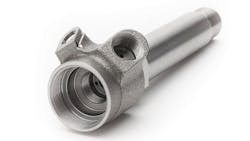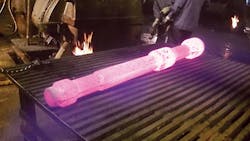New Forging Steels Prove Valuable in Performance
As with new forging technology, new forging materials are emerging with greater frequency thanks to better simulation technologies, better data management capabilities — but especially because of increasingly specific application requirements.
In the latter case, the applications are guided as much by forging producers as by forging buyers. Dr. Hans-Willi Raedt, v.p. and head of Advanced Engineering for Hirschvogel Holding, observed that “cost and resource efficiency” are among primary drivers of new developments in forged materials as well as automotive parts, and Hirschvogel’s new H2 steel — an alternative to 16MnCr5 — addresses both factors.
Hirschvogel Automotive Group manufactures forged steel and aluminum parts at eight sites in Germany, China, India, and Poland, as well as a plant in Columbus, OH.
H2 achieves strength and durability thanks to air cooling after forging heat, qualities attained by 42CrMo4 only after heat treatment. “The cost and energy efficiency of H2 results from the omission of the quenching and tempering process that is necessary with heat-treatable steel,” Raedt noted.” H2 also achieves resource and cost efficiency, as no scarce alloying elements are used.”
Recently H2 earned its first production-volume orders, from two different sources for different applications.
The first order involves a common rail for a diesel engine. The part will be hot forged in multiple stages before air cooling from the forging heat. “Until now, the precipitation-hardening ferritic-pearlitic steel 38MnVS6 was used almost exclusively for this part family,” according to Raedt. “H2 improves the mechanical properties of this part without going through the cost- and energy intensive production chain of a heat-treatable steel.
The second large order is for a diesel fuel injector, a product area largely served by 42CrMo4 steel. By using H2, the part can be produced more cost efficiently, with the promise of increased performance.
While Hirschvogel promises that H2 developments will continue, focusing on new market applications where it may replace more expensive case-hardened steels, material development and qualification times for critical aerospace components range from 10 to 20 years. The Materials Genome Initiative (MGI) was established to reduce development cost by cutting qualification-development time to less than 10 years.
Materials design group QuesTek Innovations LLC managed to accelerate the material development of M54 steel from a clean sheet design to a fully qualified, commercially available alloy in just six years, under a project funded by the U.S. Navy Naval Air Systems Command (NAVAIR) Small Business Innovation Research fund.
In late 2013, the U.S. Navy tested and qualified hook shank arresting gear components made from Ferrium M54 steel for the T-45 aircraft, in part because it more than doubled component life over the Hy-Tuf steel already in use.
Ferrium M54 is commercially produced by Carpenter Technology under license from QuesTek.
Qualification life for the Hy-Tuf components was 1,020 arrests and for M54 was 2,300 arrests, with the same geometry. The advantages of Ferrium M54 steel include superior strength, toughness, fatigue resistance, and stress corrosion cracking (SCC) resistance.
An order for 40 Ferrium M54 steel hook shanks has been authorized, and QuesTek will manage material procurement, forging, machining, heat treat and finishing. A preliminary USN analysis of procurement costs showed that the finished cost of Ferrium M54 steel hook shanks is only ~10% more than hook shanks made with Hy-Tuf; but, because of the greater service life of M54 hook shanks, the cost savings is expected to exceed $3 million.
Also, because the M54 hook shanks were qualified with a longer field life, fewer components will be required, thereby reducing waste and improving fleet logistics.
Given Ferrium M54’s performance, the Navy has also agreed to allow the new steel to replace 300M steel on selected F/A-18 aircraft landing gear components, generally without requiring component level testing or full requalification.
About the Author
Robert Brooks
Editor/Content Director - Endeavor Business Media
Robert Brooks has been a business-to-business reporter, writer, editor, and columnist for more than 20 years, specializing in the primary metal and basic manufacturing industries. His work has covered a wide range of topics including process technology, resource development, material selection, product design, workforce development, and industrial market strategies, among others.
Currently, he specializes in subjects related to metal component and product design, development, and manufacturing—including castings, forgings, machined parts, and fabrications.
Brooks is a graduate of Kenyon College (B.A. English, Political Science) and Emory University (M.A. English.)


